Thursday 3 March 2016
White: I. Lappin (132) - Black: K. Nevols (132)
Having lost four of my last five games, my confidence was still low. However I had not been playing too badly in the club championship and, with three games to go, stood a good chance of qualifying for the final group.
This was one of my main rivals, a top club player, with an equal grading. A tough but eventful game was expected - as so it proved.
1. g4
The Grob! Many years ago I had looked at this with an old Michael Basman audio chess cassette. It is one of those openings which makes you scoff at first but get sucked into complications. It must be treated with respect.
1. ... c6
The theory of the Grob involves a bishop on g2 and pawns hitting the centre - so I decide a cautious first move to solidify the diagonal.
2. h4
The Basman system uses 2. h3.
2. .... d6
Playing with d5 and e5 might be more accurate but I'm being cautious against any plans of Bg2, c4 and Qb3/a4.
3. g5
Now I am not sure what is happening but was mindful of my earlier game at Hastings (Game 7) where I got squashed by pawn advances. The computer now recommends 3. .. h6 but I want to develop a piece.
3. .... Bg4
4. d4 h6
In the Hastings game I mentioned earlier, I got in a right mess trying to develop my kingside pieces - especially the knight - and so I now aim to solve that issue. 5. Bh3 might be good for White here.
5. Bg2 Qa5+
The plan is to get my king castled as soon as possible by developing and also attempting to disrupt White's development.
6. Bd2 Qb6
7. Bc3 e6
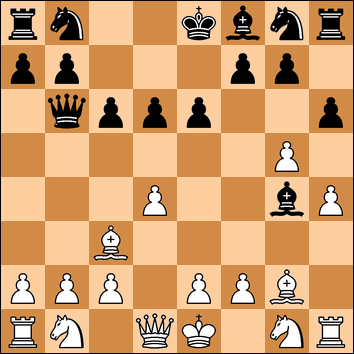
I am now thinking of sorting out the kingside and using the e7 square to move pieces about.
8. b3
Planning to drop the bishop back to b2 and play c4 but it is noticeable that no-one's knights have yet been touched.
8. .... hxg5
9. hxg5 Rxh1
10. Bxh1 Ne7
Planning to come to g6 to think about the h4 square.
11. Qd2 Ng6?!
White now could play 12. Ba5 where I had in mind maybe 12. ... Qb5 and then off to Qf5. However the pieces could be pushed back by a well-timed f3 and e4. So 12. .. Qa6 keeps things with White marginally better.
12. Na3 d5
13. Bb2
The computer now makes Black clearly better and agrees with my forthcoming plan to hit the kingside with Bd6-f4.
13. . Bd6
At this stage I was quite satisfied with how things were standing. My pieces were better developed and I had in mind moves like Nbd7, Ke7, Rc8 or Rh8. White might be thinking about castling but at the moment 14. O-O-O results in 14. .. Bf4 15. e3 Bxd1.
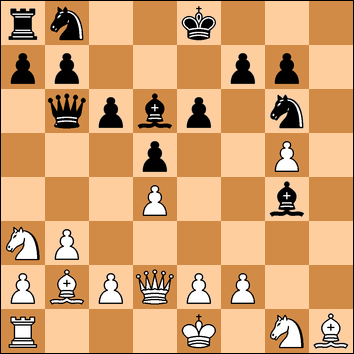
14. f3?!
A surprise. Blocking in both knight and bishop - and also presenting me with a chance to dislodge his king before it disappears into the queenside. 14. e3 may have been better.
14. .. Bg3+
15. Kd1 Bh5
I begin to regret this and think I should have played 15 ... Bf5. The idea was to prevent White from playing 16. e4 and this is the correct plan.
16. e3
This clears the second rank for the queen to move over but I noticed it opened up the a6-f1 diagonal.
16. ... Bd6
17. c3 Be7?
Completely overlooking White's next move. I can't explain why I didn't play 17. .. Qa6. After 18. Nc2 Nd7 I'm looking good.
18. Qh2
It was now with horror that I remembered the bishop! There is no way to protect it! I had a grim ponder and played the move I had seen earlier.
18. ... Qa6
With the double threat of taking a piece on a3 and checking on the f1 square, which would look good if I had no forgotten that my bishop was on an undefended square with nowhere to go.
If now 19. Nc2 then Qd3+ 20. Qd2 Qf5! (not sure if I saw this move) or 20. Kc1 Bxg5 21. Qxh5 Bxe3+ 22. Nxe3 Qxe3+ 23. Kb1 Qxg1+ (or 23. Kc2 Qf2+) with Black having much the better position. White finds the best move.
19. Kc2 Bxa3
The computer spots an interesting sequence with 19. .. Nd7!? 20. Qxh5 O-O-O with Rh8 to come.
20. Bxa3 Qxa3
21. Qxh5 Nd7
Now the h-file is in my thoughts. If now 22. Qh7 then 22. .. Ke7! as 23. Qxg7 is answered by 23. .. Rh8 coming down to h2.
22. f4 O-O-O
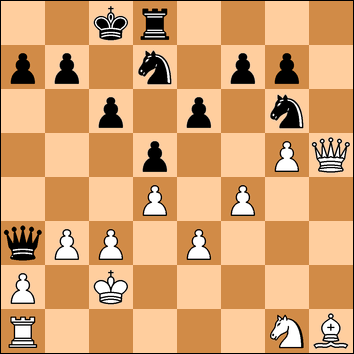
Although both my bishops had gone, I still had the feeling I must be better here, due to a safe king, and so I intend to now open up the centre so my knights could get more involved.
23. Qd1 Rh8
24. Nf3 c5?!
Opening up the centre as planned although 24. ... Ne7 planning to come to the f5 square should be first.
25. Qc1 Qa6
No intention of exchanging queens with an attack on its way.
26. Qe1 cxd4
27. cxd4 Kb8
Opening up the c-file for the rook. However, the computer now thinks that Black has lost his advantage.
28. Kb2 Ne7
29. Bg2 Nf5
30. Bf1 Qb6
31. Bd3 Nd6
Three consecutive bishop moves has considerably improved its position.
32. Rc1
And now White is on the front foot.
32. .... a5
I quite like this move making his king slightly less safe and displaying intentions that I have not given up playing for the win.
33. a4 Ka8
My plan now is to redeploy my pieces where they might be more useful. The king moves out of the way for the knight to reach c6. White now guards the second rank before advancing the knight.
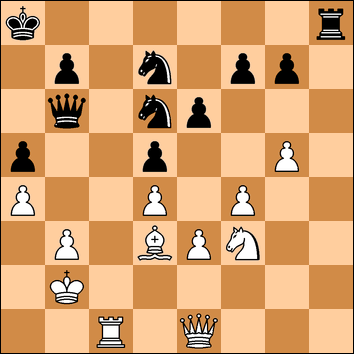
34. Rc2 Nb8
35. Ne5 f6
Much as I loved this active defence I think 35. .. Nc6 might be better. After all, that was the whole point of Ka8.
36. Ng6 Re8
37. gxf6 gxf6
38. Rh2
38. Qh4! is stronger. If 38. .. f5 then 39. Ne5. If 38. ... Qd8 then 39. Qh7 adds to the pressure although 39. .. Qd7 might be able to hold.
38. ... Nc6
39. Rh8?
I was pleased to see this move. By exchanging rooks and temporarily exiling the knight, Black gets a chance to counter.
39. ... Rxh8
40. Nxh8
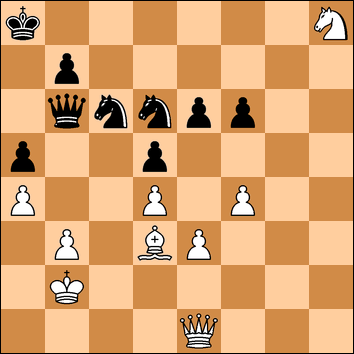
40. ... f5?
And goes the wrong way. 40. ... e5! is far stronger opening up the centre and the queen's diagonal towards the e3 pawn. One line is 41. fxe5 fxe5 42. dxe5 Nxe5 with the threat of Nc4, or 41. dxe5 fxe5 42. Ng6 e4 43. Bf1 Nf5. White will not be able to defend the pawns on b3 and e3 at the same time.
This is a missed opportunity. The game is now even - but neither of us are ready to take the draw just yet!
41. Ng6 Nb4
42. Ne5 Nxd3
43. Nxd3 Ne4
Dead even! Now 44. Ne5 Qc7 45. Qc1 Qxc1+ would make it time to shake hands.
44. Qc1 Kb8
45. Nc5!?
But no! White decides to unbalance the game - and off we go again!
45. ... Nxc5
46. dxc5 Qa6
47. Qd2 Kc7
Bringing the king into the centre to take on the advancing queen.
48. b4?!
I now thought of Yuri Averbach, the great endgame expert, and wondered if he was now turning in his grave (actually Averbach is still with us aged 94!). White provocatively sacrifices a pawn and separates his queenside pawns.
48. ... axb4
49. Qxb4 Qe2+
50. Kb1
By now we were both very short of time. I could see that if I took the pawn on e3 White has 51. Qa5+ and I could not see if I could avoid White forcing the draw. I tried a few moves about.
50 . Qd1+
51. Ka2 Qc2+
52. Ka1 Qc1+
53. Ka2 Qc4+?
This was based on a quick count to see if my king could advance. Actually it could very well lead to a loss. With best play Black can hold a draw but I was nearly down to my last five minutes.
54. Ka3?
Fortunate. Had White gone all in with 54. Qxc4, as I said, I am not sure if I could have held.
54. ... Qc1+
55. Ka2 Qxe3
What the hell, I thought. Lets' grab the pawn and see what happens.
56. Qa5+ Kd7
57. Qb5+ Ke7
58. Qxb7+ Kf6
The plan. By tucking the king away, I hoped I could avoid the checks.
59. Qb2+ d4
60. Qh2
I had one free move.
60. ... Qe4
So I decided to improve the position of the queen, where it could check White's king and hopefully block some checks.
61. Qh6+ Ke7
62. Qg7+ Kd8
63. Qh8+ Kc7
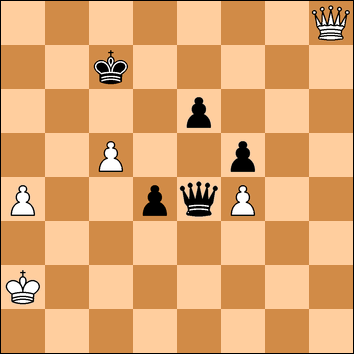
Well, dear reader, here is where we leave it. Why? My clock was now down to less than five minutes for the rest of the game, and when you get down that low, you no longer have to write down the scores.
White continued checking with the queen and my king moved forward - eventually I was able to stop the checks. My queen picked up his a-pawn with check, the c-pawn was gobbled up and eventually I forced the exchange of queens. With three pawns against one, and into the last seconds White resigned.
A happy victory after an entertaining game.
No comments:
Post a Comment